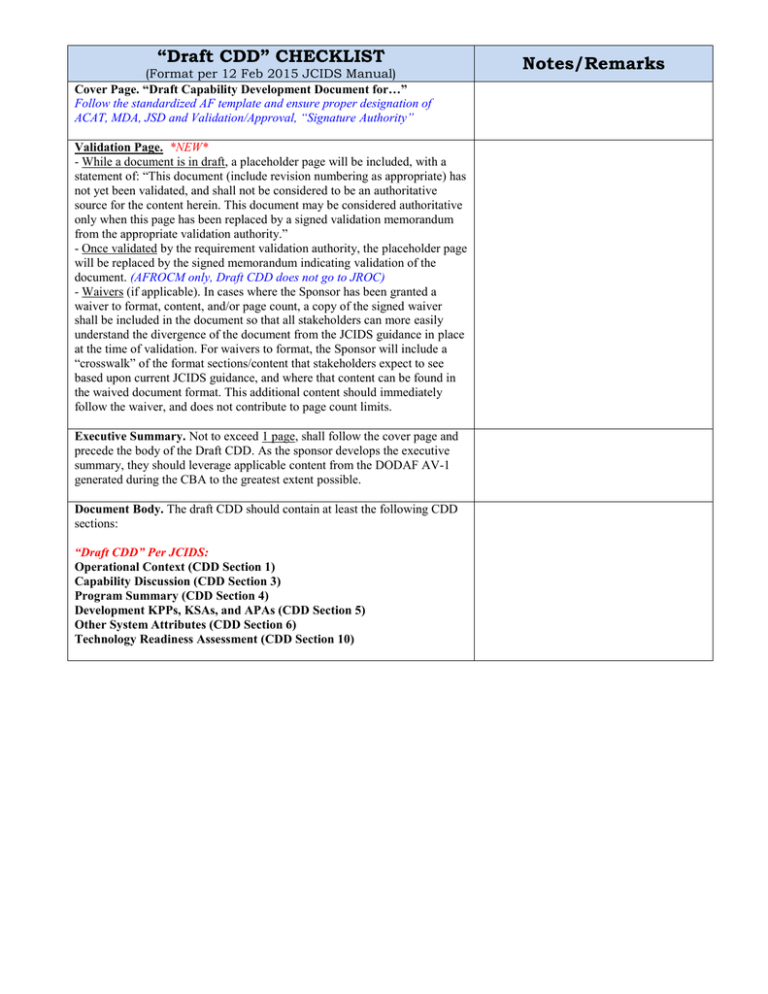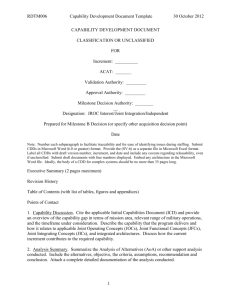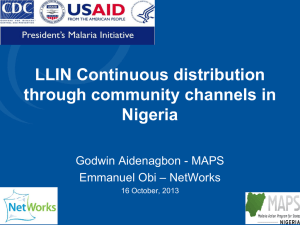Draft CDD Checklist: JCIDS Requirements & Guidance
advertisement

“Draft CDD” CHECKLIST (Format per 12 Feb 2015 JCIDS Manual) Cover Page. “Draft Capability Development Document for…” Follow the standardized AF template and ensure proper designation of ACAT, MDA, JSD and Validation/Approval, “Signature Authority” Validation Page. *NEW* - While a document is in draft, a placeholder page will be included, with a statement of: “This document (include revision numbering as appropriate) has not yet been validated, and shall not be considered to be an authoritative source for the content herein. This document may be considered authoritative only when this page has been replaced by a signed validation memorandum from the appropriate validation authority.” - Once validated by the requirement validation authority, the placeholder page will be replaced by the signed memorandum indicating validation of the document. (AFROCM only, Draft CDD does not go to JROC) - Waivers (if applicable). In cases where the Sponsor has been granted a waiver to format, content, and/or page count, a copy of the signed waiver shall be included in the document so that all stakeholders can more easily understand the divergence of the document from the JCIDS guidance in place at the time of validation. For waivers to format, the Sponsor will include a “crosswalk” of the format sections/content that stakeholders expect to see based upon current JCIDS guidance, and where that content can be found in the waived document format. This additional content should immediately follow the waiver, and does not contribute to page count limits. Executive Summary. Not to exceed 1 page, shall follow the cover page and precede the body of the Draft CDD. As the sponsor develops the executive summary, they should leverage applicable content from the DODAF AV-1 generated during the CBA to the greatest extent possible. Document Body. The draft CDD should contain at least the following CDD sections: “Draft CDD” Per JCIDS: Operational Context (CDD Section 1) Capability Discussion (CDD Section 3) Program Summary (CDD Section 4) Development KPPs, KSAs, and APAs (CDD Section 5) Other System Attributes (CDD Section 6) Technology Readiness Assessment (CDD Section 10) Notes/Remarks Operational Context (CDD Section 1), with focus on the summary of the Service and joint concepts and/or CONOPS. Ensure content is consistent with applicable DODAF OVs previously submitted, with any refinements generated from efforts to this point. The purpose of this section is to provide context for the capability requirements identified in the ICD. This information facilitates review and validation of the ICD from the standpoint of how the capability requirements contribute to the missions and activities of the joint force. 1. Narrative in the operational context section should be derived from and consistent with DODAF OVs generated during prior analysis, as modified for the scope and purpose of the Draft CDD, including the DODAF OV-1, OV-2, OV-4, and OV-5a. 2. Other than the DODAF OV-1 which is required in this section, do not include other architecture data and associated artifacts/views in the document unless specifically needed for illustration purposes in the body of the Draft CDD. Provide data for the remainder of the required DODAF OVs in the repository located at the URL specified in the reference section of the document. Requirements must be traceable to AF assigned roles, missions, and functions or other drivers (e.g. top-down direction) “Draft CDD” Per JCIDS, focus on the summary of the Service and Joint Concepts and/or CONOPS. IF the Draft CDD is a successor document to one or more previously validated requirements documents: 1. Cite the validated source documents which identified the capability requirements addressed by the Draft CDD, and ensure that any source documents not already present in the KM/DS system are provided to the Gatekeeper for reference purposes. 2. From the source document(s), summarize the operational context(s) associated with the validated capability requirements addressed by the CDD. - Ensure any changes to operational context(s) which have occurred since the original validation of the capability requirements are addressed in this section. - Ensure any key intelligence support capabilities required to enable the capability solution’s operational activities are addressed and documented within the operational context. - Include the DODAF OV-1 in this section, and where applicable, ensure high-level intelligence system connectivity and interoperability are accurately and adequately illustrated in the DODAF OV-1. IF an ICD waiver has been granted and the Draft CDD is not based upon a previously validated requirements document, provide the operational context as outlined for Section (1) of an ICD. In this case, follow the ICD format for Section 1 Capability Discussion (CDD Section 3), with focus on the summary of the previously validated capability requirements being addressed in the Draft CDD. Ensure content is consistent with applicable DODAF CVs previously submitted, with any refinements generated from efforts to this point. The purpose of this section is to identify the validated capability requirements and associated capability gaps addressed by the Draft CDD, and to outline the results of related studies or analysis performed since validation of the capability requirements. 1. Narrative in the capability discussion section, especially the discussion of dependencies, should be derived from and consistent with DODAF SV-8 generated during prior analysis, as modified for the scope and purpose of the Draft CDD. 2. If any refinements to capability requirements have been made in the analysis leading up to the Draft CDD, the Sponsor will update previously submitted DODAF CVs to be consistent with the Draft CDD and the DODAF SV-8. 3. Data for the required DODAF SV-8, and modifications to any previously submitted DODAF CVs, is to be provided in the repository located at the URL specified in the reference section of the document. IF the Draft CDD is a successor document to one or more previously validated capability requirement documents: 1. Summarize all related analyses and/or studies conducted to derive the KPPs, KSAs, and APAs presented later in the Draft CDD. Ensure the summary includes any intelligence-related analyses considered. Include the alternatives, objective, criteria, assumptions, recommendations, and conclusion. Ensure that final reports, or other resulting products, of studies or analyses not already present in the KM/DS system are uploaded for reference purposes. 2. Provide a table that briefly describes the contribution this Draft CDD makes to the fulfillment of capability requirements and closing of capability gaps described in the applicable ICDs, and the relationships to other CDDs, CPDs, or DCRs that also support these capability requirements. - Discuss the relationship of the capability solution described in the Draft CDD to other materiel and non-materiel capability solutions contributing to satisfying the capability requirements. - Discuss dependencies on separate DCRs in this section, and discuss any new/additional DOTmLPF-P changes 3. The DODAF SV-8 captures, as a function of time, all external dependencies between the capability solution articulated in the CDD and previously fielded and planned capability solutions, including interactions with intelligence capabilities where appropriate. This provides insight into the evolution of dependencies and enablers over the planned life-cycle of the capability solution. - Use the narrative in this section to discuss particularly critical dependencies, and those with known risks or other issues. - In SoS capability solutions, the Sponsor is responsible for ensuring that related capability solutions, identified in other CDDs, CPDs, and DCRs, remain compatible and that the development is synchronized. These related capability solutions should tie to a common ICD or set of ICDs. In cases where development of SoS capability solutions involves multiple solution Sponsors, a lead Sponsor should be identified to coordinate efforts across organizations. - Address whether the capability solution will be subject to, or affected by, any undeveloped (or underdeveloped) intelligence technologies, or will be affected by the deactivation of previously fielded intelligence programs. Consider whether this will affect the effectiveness and timely delivery of the capability solution or increment. Ensure all timeframes for any enabling or programrequired/dependent intelligence capabilities (previously fielded and future) are consistent with the capability solution’s development schedule and planned IOC and FOC. IF an ICD waiver was approved and the Draft CDD is not based upon a previously validated capability requirement document, provide the capability requirement and associated capability gap information outlined for Section (3) of an ICD in addition to the content outlined in this section. In this case, follow the format for section 3 of the ICD Program Summary (CDD Section 4), with focus on the synchronization of SoS efforts across other CDDs, CPDs, and DCRs, and identification of dependencies on any legacy or future enabling capabilities. The purpose of this section is to outline the overall approach for developing and fielding one or more capability solutions to satisfy the validated capability requirements and associated capability gaps, and to identify related interdependencies which must be satisfied to provide a successful capability solution. “Draft CDD” Per JCIDS, focus on the synchronization of SoS efforts across other CDDs, CPDs, and DCRs Provide a summary of the overall program strategy for reaching full capability and, if applicable, the relationship between increments defined in the CDD. - Carefully address the considerations (e.g., technologies to be developed, other systems in the FoS or SoS, inactivation of legacy systems) that are relevant to the incremental delivery plan. - For follow-on increments, provide an update on the acquisition status of previous increments, and discuss any updates to the program strategy to reflect lessons learned from previous increments, changes in approved Service and joint concepts, CONOPS, or the DOD IEA and the solution architecture or other pertinent information. Define what actions, when complete, will constitute attainment of IOC and FOC of the current increment. - Specify the target date for IOC and FOC attainment based on discussions and coordination between the requirement Sponsor and the acquisition community. - Describe the types and quantities of assets required to attain IOC and FOC. - Identify the operational units, including other DOD Components or government agencies or allied/partner nations if applicable, that will employ the capability solution, and define the quantities required for each organization. This information should leverage and be consistent with the DODAF OV-4 generated during prior analysis, as updated for the scope and purpose of the CDD. - Total quantities must include the required operational inventory, as well as quantities required for training, spares, scheduled repair/overhaul pipeline, and anticipated attrition over the projected life cycle, to maintain the required operational and training inventory. Initial production planning should be based upon these quantities, and changes to these quantities may trigger a JROC/JCB Tripwire review in accordance with the JCIDS Manual. Schedule and Quantity should balance operational need and affordability (this will be considered part of the validation, along with KPPs, etc.) Development KPPs, KSAs, and APAs (CDD Section 5), with focus on the initial/draft performance attributes resulting from the AoA or similar studies. Initial/draft attributes for the six mandatory KPPs, or justification for why they are not applicable, must also be provided. Ensure content is consistent with the DODAF SV-7, drafted to provide traceability between previously validated capability requirements and he proposed KPPs, KSAs, and APAs of the recommended capability solution. The purpose of this section is to outline the development KPPs, KSAs, and APAs intended to satisfy the validated capability requirements and associated capability gaps. Sponsors should avoid over specification of KPPs/KSAs, and APAs unless essential to addressing a specific capability requirement or mandatory KPP. Technical specifications are: 1) derived from and traceable to the operational requirements in the CDD and 2) documented in the SRD “Draft CDD” Per JCIDS, focus on the initial/draft performance attributes resulting from the AoA or other studies/analyses, including the mandatory KPPs. Initial/draft KPPs, KSAs, and APAs. Correlate each KPP, KSA and APA to the operational attributes of the capability requirements defined in the ICD and the Tier 1 through Tier 3 JCAs to which they contribute directly. - Ensure the parameters most critical to mission effectiveness are captured as KPPs. -The narrative in this section should be derived from and consistent with DODAF CV-3, SV-7, and SV-8 generated during prior analysis, as modified for the scope and purpose of the Draft CDD. a. If the Draft CDD is describing multiple increments, clearly identify which KPPs, KSAs, or APAs apply to each increment and the development threshold/objective values for each. b. If degraded levels of performance are acceptable under certain mission environments or conditions, articulate separate development threshold/objective values for the affected KPPs, KSAs, and APAs. c. If the Draft CDD is describing a SoS solution, it must describe the KPPs, KSAs, and APAs for the SoS level of performance as well as any unique KPPs, KSAs, or APAs for each of the constituent systems. d. Ensure identification of KPPs, KSAs, and APAs that are dependent upon or enabled by intelligence resources or support, including any additional CIPs which must be tracked by the IC to ensure continuing relevance of the development threshold and development objective values associated with KPPs, KSAs, and APAs. In most cases, CIPs will be associated with threat-dependent capability requirements identified in the ICD, and traceability of KPPs, KSAs, and/or APAs to those capability requirements eliminates the need to identify additional CIPs for specific KPPs, KSAs, and/or APAs. However, in cases where the capability solution has additional threat dependencies associated with its specific KPPs, KSAs, and/or APAs, additional CIPs may be identified and associated with KPPs, KSAs, and/or APAs. Ensure that intelligence-related KPPs, KSAs, and APAs are supported by adequate information and analysis, and rationale for each is consistent with the analysis and findings of the applicable intelligence ICDs. Initial/draft THRESHOLD AND OBJECTIVE VALUES. Present each attribute in output-oriented, measurable, and testable terms. - These KPPs, KSAs, and APAs should reflect MOPs for the system rather than MOEs in conducting the mission, as the latter should instead be evaluated against the capability requirements identified in the ICD and the DODAF CV-3. Ensure parameters chosen are measurable, testable, and support efficient and effective T&E. - Provide development threshold values for each which represent the value below which performance would require re-evaluation of military utility in the applicable CONOPS. Provide development objective values in cases where the increased performance level of a parameter provides significant increases in operational utility. If the development objective/threshold values are the same, indicate this by including the statement “threshold = objective.” Default position is T = O (must provide solid rationale if different) - Differences between development threshold/objective values also provide trade space for the Sponsor to explore during the EMD phase of acquisition without having to revalidate the CDD to pursue different levels of performance. The PM may use this information to provide incentives for the development contractor or to weigh capability tradeoffs between development threshold/objective values. Initial/draft MANDATORY KPPs. In addition to KPPs essential to the capability requirements being addressed by the CDD, Sponsors must include the six mandatory KPPs detailed in the JCIDS Manual unless waived by the certifying or endorsing organization. 1. For each mandatory KPP, provide specific attributes related to the KPP which must be met rather than a generic statement that the endorsements for the KPPs will be obtained. 2. Not all mandatory KPPs will be applicable to every requirement, Sponsors may either implement the KPPs or articulate why a particular KPP is not applicable 3. Exclusion of a mandatory KPP is subject to the approval of the certifying or endorsing organization. For documents with a JSD of Joint Information, the Sponsor provides certifications or endorsements, and any waivers thereof. For documents with any other JSD, the Joint Staff provides certifications or endorsements, and any waivers thereof. Provide tables summarizing specified KPPs, KSAs, and APAs in threshold/objective format, as illustrated in the JCIDS Manual. - If detail associated with each KPP, KSA, and APA cannot be adequately captured within the tables, additional detail may be provided in separate numbered subparagraphs. Note that the tables shown in the JCIDS Manual are examples, and Sponsors may adapt the table formats as needed, provided the required information is clearly understandable to stakeholders. Other System Attributes (CDD Section 6), with focus on attributes which require significant efforts during the TMRR phase of acquisition. The purpose of this section is to identify any other attributes not previously identified, especially those that tend to be design, cost, or risk drivers. - Any attributes which are critical to mission success should be identified as KPPs rather than attributes in this section “Draft CDD’ per JCIDS, focus on attributes which require significant TMRR Phase efforts. Other system attributes may include, but are not limited to: 1. Embedded instrumentation, electronic attack (EA), and wartime reserve mode (WARM) requirements. 2. Human Systems Integration (HSI) considerations that have a major impact on system effectiveness and suitability. 3. Natural environmental factors (climatic design type, terrain, meteorological and oceanographic factors, impacts and effects). 4. Physical and operational security needs, including technology security, foreign disclosure, defense exportability features, and anti-tamper. 5. Weather, oceanographic and astro-geophysical support needs throughout the program’s expected life cycle, including data accuracy and forecast needs. 6. For systems that may be used in combined allied and coalition operations, issues relating to applicable US-ratified international standardization agreements which will be incorporated in the derived system requirements, 7. Transportability considerations, including how the capability solution and related materiel will be moved either to or within the theater, and identify any lift constraints. 8. Space, Weight, Power, and Cooling SWaP-C) margins and open system attributes, to ensure future flexibility and upgradability of systems and subsystems to changing technologies and threats Technology Readiness (CDD Section 10), with focus on identifying the critical technologies which need to be matured during the TMRR phase of acquisition. In cases where the CDD describes multiple increments of a capability solution, this section must describe the critical technologies to be matured for each increment. The purpose of this section is to highlight known technological challenges which may impact the ability to reach the level of performance identified in the KPPs, KSAs, or APAs or represent risk to delivering capabilities on schedule and within budget. For the Draft CDD, this section identifies specific technological risk areas which should be the focus of risk reduction efforts pursued during the TMRR phase of acquisition. This section should be consistent with the Technology Readiness Assessment (TRA), performed by the program manager. In cases where a TRA has not been completed in time to inform the Draft CDD, the Sponsor shall ensure that TRA-like analyses are used to develop this section of the Draft CDD. For each critical technology, discuss potential workaround(s) to achieve partial or complete program success in the event that the technology does not mature as anticipated. In particular, highlight how incremental acquisition strategies and/or modular open architecture approaches are being used to enable flexibility in critical technology areas. Where known, include decision points and criteria for implementing the potential workaround(s). Appendices. Only the following four appendices are allowed in the document. Additional reference material may be submitted separately in accordance with the procedures outlined in the JCIDS Manual. Note: Per J-8, any other supporting information/documentation must not use the term “Appendix” (use “Attachment” or similar term) and save those as separate files (not part of the main document file) Appendix A: References. - Ahead of other references provided in this appendix, provide a URL for required architecture data and associated artifacts/views Appendix B: Acronym List. Appendix C: Glossary. - As the sponsor develops the document glossary, they should leverage applicable terms from the DODAF AV-2 generated during the CBA to the greatest extent possible. The document glossary and the DODAF AV-2 do not have to be identical, as some terms will only apply to the document or the DODAF architecture. Terms that apply to both must be consistent between the document and the architecture products. Appendix D: (Optional) Classified Annex. A classified annex may be used in cases where only a small subset of the document needs to be protected at a higher classification level. - If the document is not a useful artifact without the content of the classified annex, then the annex should not be used and the entire document should be classified at a higher level. NOTE: When a classified annex is used, its content will count toward the document body page limits and will be indexed to align with the baseline document sections. - Except where the existence of the classified content cannot be acknowledged at the lower classification level, each section of the baseline document modified or augmented by the classified annex will refer the reader to the classified annex for additional detail. - If used, classified annexes shall be provided to the Joint Staff Gatekeeper or Joint Staff J-8, Special Access Program Coordinator (J-8/SAPCOORD) in accordance with the classification of the annex.








